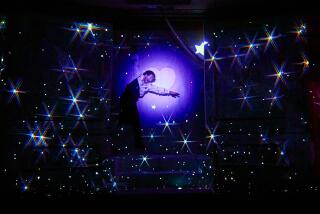Look for the Dancing Sign at a Store Near You
- Share via
SAN FRANCISCO — Take traditional silk-screening techniques, mix them with a modern audiovisual system and add a little electroluminescence. The result? Interactive Print Media, the latest in advertising technology.
IPM, from Junkyard Dogs, a San Jose-based high-tech product development company, makes it possible to create a kind of singing, dancing poster. If the idea catches on, the point-of-purchase display may never be the same.
“I have to say that no one in the advertising industry has seen anything like this before,” says Greg Brown, art director for Elgin DDB of Seattle, one of the world’s largest ad agencies. “This is the most exciting technology that is going to the market in a long time.”
You might have seen sound and motion in displays at computer or liquor stores before, but they use expensive, delicate technology, explains Gina Long, president of Lithomania Inc., a San Francisco company that creates point-of-purchase displays.
“To achieve the motion impression, neon tubes are used with a great expenditure of money and energy, and they’re cumbersome and fragile,” Long says. “Junkyard’s is the first [technology where] you don’t need a computer chip and thousands and thousands of dollars to have a light-motion interactive display.”
The Junkyard Dog display uses five thin layers of material: aclar, a clear polyethylene that resists moisture; phosphorous ink images silk-screened onto the aclar; an insulation sprayed onto the images; a conductive layer housing both the electroluminescent circuitry necessary to animate the phosphorous images and the electrical components that make sound possible; and a final application of insulation.
Electroluminescence has been around since the 1930s and was developed primarily for military aircraft lighting. In the 1970s, auto makers started to use EL, as it is sometimes called, to illuminate dashboards. Nowadays, EL is also used for cockpit lighting in commercial aircraft and for safety lighting, such as exit signs and floor lights, in commercial buildings.
“EL is well-suited to this kind of application because of its low power requirement,” says Alan Suzhany, product manager for Rockville, Md.-based Quantex, a manufacturer of electroluminescent lighting.
The technology has other possible applications. The materials used are lightweight and can be molded into different forms for use in everything from pens and clock faces to coffee cups and magazine pages.
Junkyard’s innovation--which grew from the labor of company Vice President Tamas Torma, who co-founded Junkyard with George Heropoulos, its president and CEO, in 1996--was in developing a way to print the electroluminescent material and wire it so that individual pieces of an image could be illuminated discretely and in sequence to create motion.
The EL “lamps” require a certain amount of care and feeding. They need to be protected from moisture and shielded from heat and long periods of direct sunlight. If these conditions are met, though, a display will operate for 10,000 to 100,000 hours, Junkyard says.
*
Freelance writers Purpura and Pontoniere can be reached via e-mail at [email protected]
More to Read
Inside the business of entertainment
The Wide Shot brings you news, analysis and insights on everything from streaming wars to production — and what it all means for the future.
You may occasionally receive promotional content from the Los Angeles Times.









